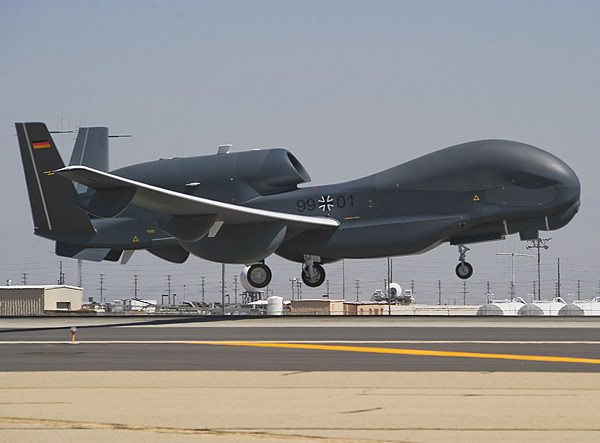The Euro Hawk is still making waves in Germany, even after the defense ministry pulled the plug on the surveillance drone project last week. The problems were obvious long before the debacle.
The German representatives involved in the Euro Hawk project still sounded confident back in December of 2012.
“The project has reached a level of maturity that allows the Euro Hawk conditional entry into European airspace,” the German delegation said at the International Aerospace Conference in Montreal at the time.
Three months later, the German defense ministry’s undersecretary of state didn’t sound as convinced when questioned in Germany’s parliament. “There are tests currently being run that will definitively answer whether a procurement of Euro Hawks is justified against the backdrop of [air-space] approval problems,” wrote Thomas Kossendey in response to a parliamentary inquiry in the German Bundestag.
Out-of-control costs
By May 2013, that same defense ministry had announced the end of the Euro Hawk drone project. The costs up to that point: approximately 600 million euros ($775 million). The European Aviation Safety Agency (EASA) had reportedly announced it would not allow flights over populated areas because the drone lacks a certified detect-and-avoid system.
The problem did not come as a surprise. Developers have been working on the Euro Hawk since the start of the millenium. In 2004, EADS, the company working on the drone, warned that a collision protection system would become necessary, in particular for take-off and landing. A power point presentation that can still be accessed on the Internet says that while the drones fly at an altitude of 20,000 meters – twice as high as passenger planes – dangerous situations could arise during take-off and landing, when the drone flies through the passenger planes’ busy airspace. Oncoming planes, the presentation concludes, “do not stand a chance to prevent a collision.”
Better a miserable end
At the same time, according to an article in the Frankfurter Allgemeine newspaper last Sunday, the Bundeswehr’s WD61 department responsible for checking new purchases pointed out the very same problem. Despite those reservations, Germany’s defense ministry in 2007 signed a contract on development of the Euro Hawk with EADS and the US Northrop Grumman company. Plans did not include an automatic anti-collision system; instead, a control center on the ground was to monitor flight safety.
In 2011, a first test flight took the unmanned plane from the US to Marching in Bavaria. The drone lost radio contact to ground control for several minutes – an event that appears to confirm criticism of the missing security system.
“Security standards that apply to the Euro Hawk are consistent with standards for manned flight,” Wolfgang Staiger, head of WD61, is quoted as saying in an article on the German Air Force website, Luftwaffe.de. At the International Aerospace Conference in Montreal in December 2012, the German delegation expressly confirmed the “lack of a detect-and-avoid capacity seems to be acceptable.”
The defense ministry has meanwhile conceded that it has been aware of certification issues since 2011 – seven years after the first documents indicating the problem surfaced.
The defense ministry’s cancellation of the drone program could have another cause. The ministry appears to assume the data submitted by the US manufacturer is not sufficient for European certification. Some technical data in arms projects is always confidential. In this case, information the aviation agency needed was apparently missing. It would cost the Bundeswehr hundreds of millions of euros to run tests to determine that particular data.
“It is true that we have identified possible significant additional costs to obtain a prototype and airworthiness certificate for the Euro Hawk series,” the defense ministry’s undersecretary of state wrote in March. Further details were not available. On June 5, however, Defence Minister Thomas de Maiziere is due to appear before the defense committee.
NATO meanwhile has declared that it is not affected by the Euro Hawk debacle. The alliance also has plans for a reconnaissance drone based on the US Global Hawk; “the purchase of an existing operational system”, as a NATO official in Brussels described it. How the alliance plans to convince the European Aviation Safety Agency of the plan remains its secret.










